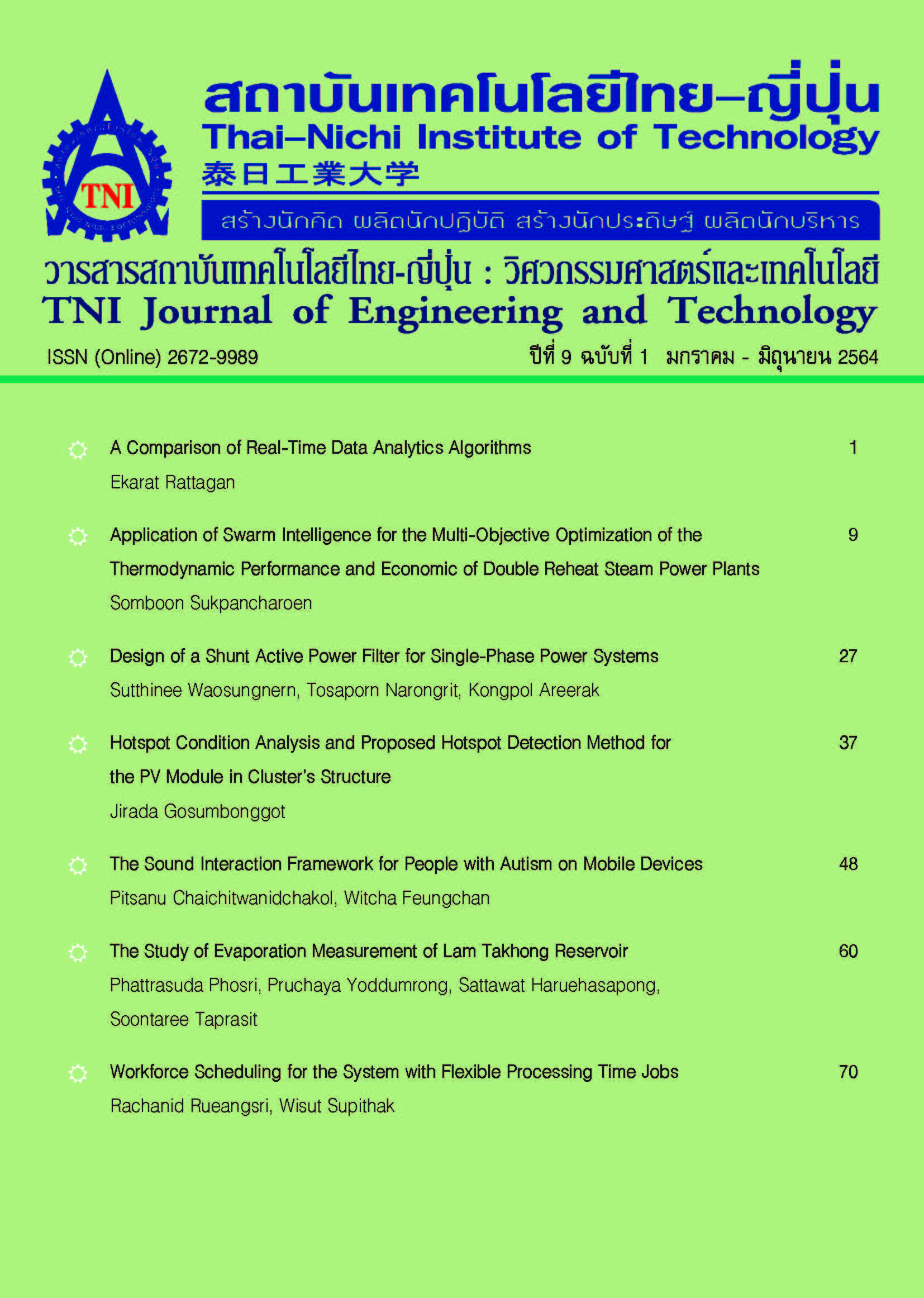กรอบการปฏิสัมพันธ์โดยใช้เสียงสำหรับผู้มีภาวะออทิสซึมบนอุปกรณ์เคลื่อนที่
Main Article Content
บทคัดย่อ
โรคออทิสซึมเป็นกลุ่มของโรคที่เกิดจากความผิดปกติในการพัฒนาของระบบประสาทที่ซับซ้อน ส่งผลให้เกิดความบกพร่องทางด้านการปฏิสัมพันธ์กับสังคมและการสื่อสาร ทำให้มีความผิดปกติด้านภาษา และการพูด บางคนไม่พูดเลย บางคนพูดเลียนแบบ หรือบางคนพูดภาษาของตนเอง ทำให้ไม่สามารถสื่อสารความต้องการของตนเองกับผู้อื่นได้ ถึงแม้ว่าโรคออทิสซึมจะยังไม่มีวิธีรักษาให้หายขาด แต่การบำบัดสามารถช่วยพัฒนาทักษะและการเรียนรู้ให้กับคนกลุ่มนี้ ส่งผลให้ความเป็นอยู่และคุณภาพชีวิตดีขึ้น ซึ่งในศูนย์วิจัยออทิสติก มหาวิทยาลัยขอนแก่น มีกิจกรรมในการฝึกทักษะการพูดโดยการใช้บัตรคำศัพท์พร้อมรูปภาพ และให้ความรู้ด้วยหนังสือหรือสไลด์ประกอบการสอน แต่เด็กไม่ให้ความสนใจในกิจกรรมนี้เท่าที่ควร จากการสืบค้นวรรณกรรมและงานวิจัยที่เกี่ยวข้องพบว่ามีการบำบัดความบกพร่องทางการสื่อสารโดยใช้แอปพลิเคชันหรือเกมบนอุปกรณ์เคลื่อนที่อย่างแพร่หลาย การใช้รูปแบบการปฏิสัมพันธ์ที่เหมาะสมจะเป็นกุญแจนำไปสู่ความสำเร็จของการบำบัดนี้ ดังนั้นในงานวิจัยนี้จึงได้นำเสนอเทคนิคการปฏิสัมพันธ์โดยใช้เสียงบนอุปกรณ์เคลื่อนที่สำหรับผู้มีภาวะออทิสซึม และนำเสนอกรอบการปฏิสัมพันธ์เพื่อเป็นแนวทางให้นักพัฒนาได้ออกแบบแอปพลิเคชันหรือเกมด้วยเทคนิคการปฏิสัมพันธ์ที่เหมาะสมกับการบำบัดความบกพร่องทางการสื่อสาร โดยที่นักพัฒนาสามารถลดระยะเวลาในการพัฒนาลงด้วยการทำตามกรอบที่นำเสนอในการเลือกการปฏิสัมพันธ์ เพื่อเป็นการยืนยันถึงประสิทธิผล งานวิจัยนี้จึงได้พัฒนาเกมตัวอย่างชื่อ “Run Animal Run” เพื่อให้ความรู้โดยใช้สื่อประสมเชิงโต้ตอบ (Interactive multimedia) และฝึกฝนทักษะการออกเสียงโดยเลือกใช้เทคนิคการปฏิสัมพันธ์จากกรอบการปฏิสัมพันธ์ที่ได้นำเสนอไว้ และนำเกมตัวอย่างนี้ไปทดลองกับอาสาสมัครที่ ศูนย์วิจัยออทิสติก มหาวิทยาลัยขอนแก่น ผลการทดลองแสดงให้เห็นว่าอาสาสมัครสามารถเรียนรู้ได้ดีขึ้นกว่าวิธีการแบบดั้งเดิม และใช้การปฏิสัมพันธ์ที่ออกแบบในการโต้ตอบกับเกมตัวอย่างได้ โดยช่วยกระตุ้นความสนใจ พร้อมทั้งพัฒนาทักษะทางด้านภาษาด้วย
Article Details
นโยบายการรับบทความ
กองบรรณาธิการวารสารสถาบันเทคโนโลยีไทย-ญี่ปุ่น มีความยินดีรับบทความจากอาจารย์ประจำ และผู้ทรงคุณวุฒิในสาขาวิศวกรรมศาสตร์และเทคโนโลยี ที่เขียนเป็นภาษาไทยหรือภาษาอังกฤษ ซึ่งผลงานวิชาการที่ส่งมาขอตีพิมพ์ต้องไม่เคยเผยแพร่ในสิ่งพิมพ์อื่นใดมาก่อน และต้องไม่อยู่ในระหว่างการพิจารณาของวารสารอื่นที่นำส่ง ดังนั้นผู้สนใจที่จะร่วมเผยแพร่ผลงานและความรู้ที่ศึกษามาสามารถนำส่งบทความได้ที่กองบรรณาธิการเพื่อเสนอต่อคณะกรรมการกลั่นกรองบทความพิจารณาจัดพิมพ์ในวารสารต่อไป ทั้งนี้บทความที่สามารถเผยแพร่ได้ประกอบด้วยบทความวิจัย ผู้สนใจสามารถศึกษาและจัดเตรียมบทความจากคำแนะนำสำหรับผู้เขียนบทความ
การละเมิดลิขสิทธิ์ถือเป็นความรับผิดชอบของผู้ส่งบทความโดยตรง บทความที่ได้รับการตีพิมพ์ต้องผ่านการพิจารณากลั่นกรองคุณภาพจากผู้ทรงคุณวุฒิและได้รับความเห็นชอบจากกองบรรณาธิการ
ข้อความที่ปรากฏภายในบทความของแต่ละบทความที่ตีพิมพ์ในวารสารวิชาการเล่มนี้ เป็น ความคิดเห็นส่วนตัวของผู้เขียนแต่ละท่าน ไม่เกี่ยวข้องกับสถาบันเทคโนโลยีไทย-ญี่ปุ่น และคณาจารย์ท่านอื่น ๆ ในสถาบัน แต่อย่างใด ความรับผิดชอบด้านเนื้อหาและการตรวจร่างบทความแต่ละบทความเป็นของผู้เขียนแต่ละท่าน หากมีความผิดพลาดใด ๆ ผู้เขียนแต่ละท่านจะต้องรับผิดชอบบทความของตนเองแต่ผู้เดียว
กองบรรณาธิการขอสงวนสิทธิ์มิให้นำเนื้อหา ทัศนะ หรือข้อคิดเห็นใด ๆ ของบทความในวารสารสถาบันเทคโนโลยีไทย-ญี่ปุ่น ไปเผยแพร่ก่อนได้รับอนุญาตจากผู้นิพนธ์ อย่างเป็นลายลักษณ์อักษร ผลงานที่ได้รับการตีพิมพ์ถือเป็นลิขสิทธิ์ของวารสารสถาบันเทคโนโลยีไทย-ญี่ปุ่น
ผู้ประสงค์จะส่งบทความเพื่อตีพิมพ์ในวารสารวิชาการ สถาบันเทคโนโลยีไทย-ญี่ปุ่น สามารถส่ง Online ที่ https://www.tci-thaijo.org/index.php/TNIJournal/ โปรดสมัครสมาชิก (Register) โดยกรอกรายละเอียดให้ครบถ้วนหากต้องการสอบถามข้อมูลเพิ่มเติมที่
- กองบรรณาธิการ วารสารสถาบันเทคโนโลยีไทย-ญี่ปุ่น
- ฝ่ายวิจัยและนวัตกรรม สถาบันเทคโนโลยีไทย-ญี่ปุ่น
เลขที่ 1771/1 สถาบันเทคโนโลยีไทย-ญี่ปุ่น ซอยพัฒนาการ 37-39 ถนนพัฒนาการ แขวงสวนหลวง เขตสวนหลวง กรุงเทพมหานคร 10250 ติดต่อกับคุณพิมพ์รต พิพัฒนกุล (02) 763-2752 , คุณจุฑามาศ ประสพสันติ์ (02) 763-2600 Ext. 2402 Fax. (02) 763-2754 หรือ E-mail: JEDT@tni.ac.th
References
M. Elsabbagh, G. Divan, Y. J. Koh, Y. S. Kim, S. Kauchali, C. Marcín, C. M. Nava, V. Patel, C. S. Paula, C. Wang, M. T. Yasamy, and E. Fombonne, “Global prevalence of autism and other pervasive developmental disorders,” Autism Research, vol. 5, no. 3, pp. 160–179, Jun. 2012.
Komchadluek. “Department of Mental Health reveals Thailand have three hundred thousand children with autism,” KOMCHADLUEK.net. https://www.komchadluek.net/news/regional/288899 (accessed Sep. 26, 2020).
A. S. Shminan, R. A. Adzani, S. Sharif, and N. K. Lee, “AutiPECS: Mobile based learning of picture exchange communication intervention for caregivers of autistic children,” in 2017 Int. Conf. Computer and Drone Applications (IConDA), Kuching, Malaysia, Nov. 2017, pp. 49–54.
F. Susanti, D. Junaedi, and V. Effendy, “Communication learning user interface model for children with autism with the goal-directed design method,” in 2019 7th Int. Conf. Information and Communication Technology (ICoICT), Kuala Lumpur, Malaysia, Jul. 2019, pp. 1–6.
I. Torii, K. Ohtani, T. Niwa, A. Yamamoto, and N. Ishii, “Augmentative and alternative communication with digital assistant for autistic children,” in 2012 IEEE Int. Conf. Emerging Signal Processing Applications, Las Vegas, NV, USA, Jan. 2012, pp. 71–74.
G. Hornero, D. Conde, M. Quílez, S. Domingo, M. P. Rodríguez, B. Romero, and O. Casas, “A wireless augmentative and alternative communication system for people with speech disabilities,” IEEE Access, vol. 3, pp. 1288–1297, 2015.
N. Heni and H. Hamam, “Design of emotional educational system mobile games for autistic children,” in 2016 2nd Int. Conf. Advanced Technologies for Signal and Image Processing (ATSIP), Monastir, Tunisia, Mar. 2016, pp. 631–637.
M. Santiputri, E. B. Sembiring, N. Z. Janah, and M. K. Mufida, “Abangmanis: Speech theraphy for autism monitoring mobile application,” in 2019 2nd Int. Conf. Applied Engineering (ICAE), Batam, Indonesia, Oct. 2019, pp. 1–6.
S. An, X. Feng, Y. Dai, H. Bo, X. Wang, M. Li, J. Z. Woo, X. Liang, C. Guo, and C. X. Liu, “Development and evaluation of a speech-generating AAC mobile app for minimally verbal children with autism spectrum disorder in Mainland China,” Molecular Autism, vol. 8, no. 1, pp. 1-12, 2017.
American Psychiatric Association, Diagnostic and statistical manual of mental disorders, 5th ed. Arlington, VA, USA: American Psychiatric Publishing, 2013.
U. Trangkasomba, Helping an autistic children, 2nd ed. Bangkok, Thailand: SUNTA PRESS (in Thai), 2007.
P. T. Torres, Learning excellence: A master course in learning how to learn, 2nd ed. Manila, Philippines: Training Systems Associates, Inc., 2002.

